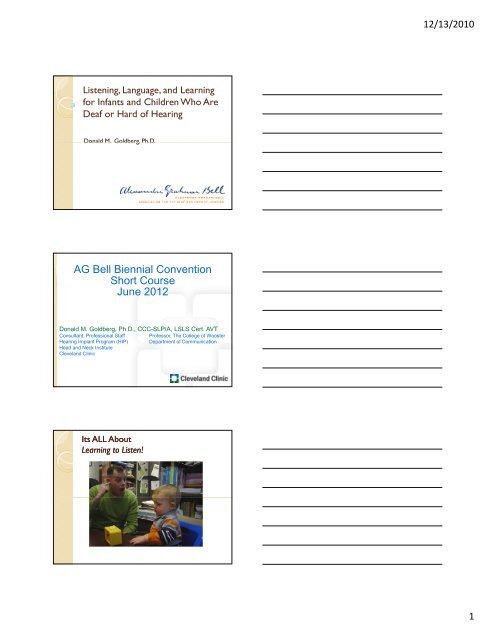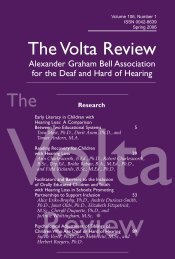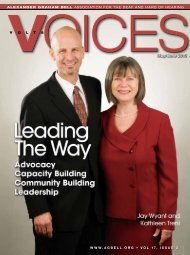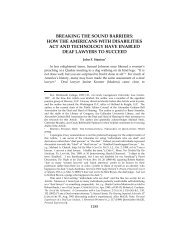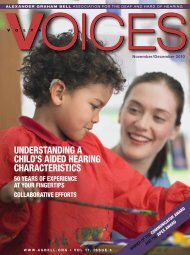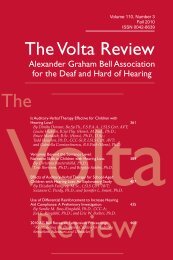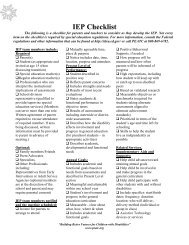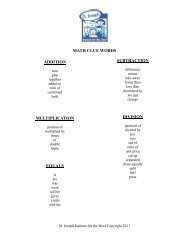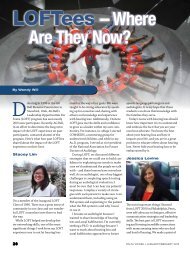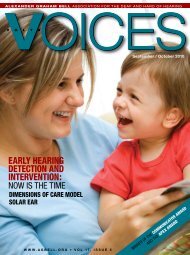Presentation - Alexander Graham Bell Association
Presentation - Alexander Graham Bell Association
Presentation - Alexander Graham Bell Association
You also want an ePaper? Increase the reach of your titles
YUMPU automatically turns print PDFs into web optimized ePapers that Google loves.
12/13/2010<br />
Listening, Language, and Learning<br />
for Infants and Children Who Are<br />
Deaf or Hard of Hearing<br />
Donald M. Goldberg, Ph.D.<br />
AG <strong>Bell</strong> Biennial Convention<br />
Short Course<br />
June 2012<br />
Donald M. Goldberg, Ph.D., CCC-SLP/A, LSLS Cert. AVT<br />
Consultant, Professional Staff Professor, The College of Wooster<br />
Hearing Implant Program (HIP) Department of Communication<br />
Head and Neck Institute<br />
Cleveland Clinic<br />
2<br />
Its ALL About<br />
Learning to Listen!<br />
1
12/13/2010<br />
Agenda<br />
• Communication Options/”Communication<br />
Opportunities”<br />
• Questions to Ask of ALL Options<br />
• Auditory-Verbal Therapy Principles<br />
• Auditory-Verbal Education Principles<br />
• Audiology: The Foundation of Auditory<br />
Teaching<br />
• Introduction to Hearing Sensory Technology<br />
Agenda<br />
• Assessment of Auditory Functioning<br />
• The Auditory “Hierarchy”/Levels of Functioning<br />
• AG <strong>Bell</strong> Academy for Listening and Spoken<br />
Language<br />
◦ LSLS Cert. AVT<br />
◦ LSLS Cert. AVEd<br />
• Research Support/Resources: Auditory Teaching<br />
• Resources: Cochlear Implants<br />
ESSENTIAL KNOWLEDGE AREAS OF A<br />
LISTENING AND SPOKEN LANGUAGE SPECIALIST<br />
Emergent Literacy<br />
6%<br />
Education 6%<br />
History, Philosophy,<br />
and Professional<br />
Issues 4%<br />
Strategies for<br />
Listening and<br />
Spoken Language<br />
Development 18%<br />
Parent Guidance,<br />
Education and<br />
Support 13%<br />
Hearing and Hearing<br />
Technology 12%<br />
Auditory Functioning<br />
16%<br />
Spoken Language<br />
Communication<br />
16%<br />
Child Development<br />
9%<br />
2
12/13/2010<br />
Auditory-Based Teaching Does NOT Merely Mean<br />
Putting An Acoustic Hoop In Front of Your Mouth!<br />
A Caveat PLEASE!<br />
A workshop/presentation/short course does NOT<br />
prepare one to become a fully trained<br />
interventionist<br />
for children who are deaf or hard of hearing!<br />
A “jump start” perhaps – but expertise,<br />
both academically and clinically –<br />
in child development, parent/family counseling,<br />
speech-language pathology, audiology, education<br />
of the hearing impaired, teaching spoken<br />
language through listening, among others, –<br />
IS ALSO REQUIRED!<br />
Opening Doors:<br />
Technology And<br />
Communication Options for Children With Hearing Loss<br />
Opening Doors: Technology And Communication<br />
Options for Children With Hearing Loss<br />
- Your Beautiful Child<br />
- Windows of Opportunity<br />
- Quick Facts<br />
- First Reactions<br />
- Early Intervention<br />
- Where Do I Turn?<br />
- Groups Specializing In<br />
Hearing Loss and Deafness<br />
- Breaking the Sound Barrier<br />
(Hearing Aids, Cochlear<br />
Implants)<br />
- Exploring Communication<br />
Options (Auditory-Oral,<br />
Auditory-Verbal Verbal, Cued<br />
Speech, Sign Language)<br />
From the U.S. Department of Education<br />
www.ed.gov/about/offices/list/osers/reports.html.<br />
&<br />
www.cdc.gov/ncbddd/ehdi<br />
3
12/13/2010<br />
Communication Modes/Options<br />
Opportunities<br />
• Auditory-Verbal<br />
• Auditory/Oral<br />
• Cued Speech<br />
• Verbotonal<br />
• Total Communication<br />
• Simultaneous Communication)<br />
• New: ASL/English Bimodal Bilingual<br />
• Manual Communication<br />
- MCE/Sign Systems<br />
- ASL (Bi-Bi)<br />
Which communication<br />
approach is the “BEST”<br />
for MY child?<br />
Adapted from Schuyler & Sowers, 1998<br />
Questions to Ask/Issues to<br />
Consider<br />
• Where does one start?<br />
• What is the child’s age at time of<br />
identification?<br />
• What is the degree of the hearing loss?<br />
• With amplification i -- how well does the child<br />
“hear” spoken language?<br />
• What early intervention & educational<br />
resources are available in or near your<br />
community?<br />
• …<br />
4
12/13/2010<br />
Questions to Ask/Issues to Consider<br />
• If selecting ANY option -- how willing are the<br />
primary caregivers to learn the option’s<br />
requisite “components” (e.g., sign, cue,<br />
“technique” fluency/ competence)?<br />
• What is the family’s commitment to a<br />
selected approach?<br />
• How does a selected option work for the<br />
family?<br />
• What are the goals for the child?<br />
• …<br />
Questions to Ask/Issues to<br />
Consider<br />
• What educational options exist “down the<br />
road”?<br />
• What other factors, if any, need to be<br />
considered?<br />
• What are the potential benefits of each<br />
approach?<br />
and<br />
• What are the potential challenges of each<br />
approach?<br />
CONSIDER<br />
Look at the graduates of<br />
each program and do<br />
NOT only see the<br />
“STARS”!<br />
5
12/13/2010<br />
NO decision<br />
a parent<br />
makes is a<br />
“WRONG”<br />
decision!<br />
Principles of A-V Therapy Practice<br />
(AG <strong>Bell</strong> Academy for Listening and Spoken Language, 2009)<br />
1. Early diagnosis, audiologic<br />
management, and AVT.<br />
2. State-of-the-art hearing<br />
technology to obtain maximum<br />
auditory stimulation.<br />
3. Guide and coach parents to help<br />
their child use hearing as the<br />
primary sensory modality in<br />
developing listening and spoken<br />
language.<br />
Principles of A-V Therapy Practice<br />
4. Guide and coach parents as<br />
primary facilitators of child’s<br />
listening and spoken language<br />
development through active<br />
consistent participation in<br />
individualized id d AVT.<br />
5. Guide and coach parents to create<br />
environments that support<br />
listening throughout the<br />
child’s daily activities.<br />
6
12/13/2010<br />
Principles of A-V Therapy Practice<br />
6. Guide and coach parents to help<br />
integrate listening and spoken<br />
language into all aspects of<br />
the child’s life.<br />
7. Guide and coach parents to use<br />
natural developmental<br />
patterns …<br />
8. Guide and coach parents to help<br />
their child self-monitor spoken<br />
language through listening.<br />
Principles of A-V Therapy Practice<br />
9. Administer on-going formal and informal<br />
diagnostic assessments to develop<br />
individualized A-V treatment plans –<br />
diagnostic therapy – to evaluate<br />
clinical effectiveness<br />
and<br />
10. Promote education in “regular”<br />
classrooms with peers with<br />
“typical” hearing and with appropriate<br />
support services from early childhood<br />
onwards.<br />
Principles of A-V Practice<br />
Above PRINCIPLES were adapted from Pollack<br />
(1970)<br />
• An A-V Practice requires all 10 principles to be<br />
in place.<br />
• “Parents” also includes other caregivers who<br />
interact with the child.<br />
7
12/13/2010<br />
Principles of Auditory-Verbal<br />
EDUCATION<br />
1. Early diagnosis, followed by immediate<br />
audiologic assessment and use of appropriate state<br />
of the art hearing technology to ensure maximum<br />
benefits of auditory stimulation.<br />
2. Promote immediate audiologic management and<br />
development of listening and spoken language for<br />
children as their primary mode of<br />
communication.<br />
3. Acoustically controlled environment<br />
throughout the child’s daily activities.<br />
Principles of A-V Education<br />
4. Guide and coach parents to become effective<br />
facilitators of child’s listening and spoken language<br />
development in all aspects of the child’s life.<br />
5. Provide effective teaching with families and children in<br />
settings such as homes, classrooms, therapy<br />
rooms, hospitals, or clinics.<br />
6. Provide focused and individualized instruction<br />
through lesson plans and classroom activities while<br />
maximizing listening and spoken language.<br />
Principles of A-V Education<br />
7. Collaborate with parents and professionals to develop<br />
goals, objectives, and strategies for achieving the<br />
natural developmental patterns …<br />
8. Promote each child’s ability to self-monitor spoken<br />
language through listening.<br />
8
12/13/2010<br />
Principles of A-V Education<br />
9. Use diagnostic assessments to develop individualized<br />
objectives, monitor progress, and evaluate the<br />
effectiveness of the teaching activities.<br />
and<br />
10. Promote education in “regular” classrooms with<br />
peers who have “typical” hearing as early as<br />
possible, when the child has the skills to do so<br />
successfully.<br />
The Options for “Success”…<br />
Have never been more exciting!<br />
Why?<br />
- Universal Newborn Hearing Screening<br />
- Increased survival rates of<br />
“at risk” infants<br />
- Increased focus on EARLY INTERVENTION &<br />
clinical efficacy<br />
- Advances in sensory technology, most notably,<br />
cochlear implants!<br />
By using today’s incredible “sensory<br />
technology,” even children with<br />
severe and profound hearing loss<br />
can make use of auditory<br />
information to develop spoken<br />
language – through listening!<br />
9
12/13/2010<br />
Coach the parent as the<br />
primary model for listening<br />
and talking<br />
Parent guidance should be an<br />
integral part of any EI program,<br />
as it is the family members who<br />
must learn to provide the child<br />
with maximum auditory<br />
stimulation and ...<br />
who model meaningful verbal<br />
communication strategies<br />
throughout<br />
the child’s daily activities.<br />
10
12/13/2010<br />
Cornerstones of A-V Practice<br />
• Early Detection/Early Identification<br />
• Appropriate use of sensory aid/s<br />
• One-on-one intervention<br />
with full parent involvement<br />
• Absence of signs & speechreading training<br />
• Integration with hearing peers…<br />
• On-going diagnostic therapy<br />
Auditory-Verbal<br />
&<br />
Auditory-Based<br />
Helen Hulick Beebe<br />
Auditory-<br />
Verbal<br />
Pioneer<br />
Doreen Pollack<br />
A-V Pioneer<br />
11
12/13/2010<br />
Give back to parents<br />
their natural role as their<br />
child’s first and most<br />
important teacher<br />
(adapted from Pollack, 1970)<br />
The Sky’s the Limit!<br />
Why?<br />
• Early Identification<br />
• Audiology<br />
• Sensory Technology<br />
• Auditory Learning / Early Intervention<br />
• Professional Certification of LSLS/s<br />
Audiology<br />
The Foundation of<br />
Auditory-Based Intervention<br />
&<br />
The KEY to auditory “success”<br />
12
12/13/2010<br />
Let’s talk about HEARING!<br />
Pinna<br />
Tympanic<br />
Membrane<br />
Semicircular<br />
Canals<br />
Cochlea<br />
Hearing<br />
Nerve<br />
(VIII N)<br />
Let’s take a look ….<br />
13
12/13/2010<br />
Auditory Brain Development<br />
It’s all about the BRAIN!<br />
The ears are just the way in…<br />
1-3-6<br />
1 Before one Month of Age:<br />
Hearing Screening<br />
3 Before three Months of Age:<br />
Hearing Evaluation<br />
6 Before six Months of Age:<br />
Early Intervention<br />
www.cdc.gov/ncbddd/ehdi<br />
Tympanometry<br />
OAEs<br />
Air Conduction<br />
Tonal ABRs<br />
Air<br />
Conduction<br />
Click ABRs<br />
Bone<br />
Conduction<br />
Click ABR<br />
14
12/13/2010<br />
Audiologic Protocol<br />
• Use a battery approach:<br />
◦ Auditory Brainstem Response (ABR)<br />
◦ Otoacoustic Emissions (OAEs)<br />
◦ Auditory Steady State Response (ASSR)<br />
Auditory Steady State Response (ASSR)<br />
◦ Behavioral Observation Audiometry (BOA)<br />
◦ Visual Reinforcement Audiometry (VRA)<br />
◦ Conditioned Play Audiometry (CPA)<br />
15
12/13/2010<br />
Audiologic Recommendations<br />
On-site audiology program with the<br />
early intervention program<br />
Pediatric Test Assistant<br />
(Birth to age 3-years-old)<br />
Active parent participation<br />
Comprehensive testing protocol<br />
16
12/13/2010<br />
Audiograms<br />
X<br />
O<br />
X<br />
X<br />
X O<br />
X<br />
O<br />
X<br />
O O O<br />
Image from League for the Hard of Hearing<br />
17
12/13/2010<br />
Hearing Technology Worn Throughout the Child<br />
Waking Hours (www.almontpool.com/www.poolrafts.com)<br />
Hearing Sensory Technology<br />
Hearing Aids<br />
FM/s and other Hearing Assistive<br />
Technology (HAT)<br />
Cochlear Implants<br />
Consider Trying:<br />
• Hearinghenry.com<br />
• www.silkawear.com<br />
• www.hannaanderson.com<br />
18
12/13/2010<br />
Because EVERY dB counts!<br />
Unaided Testing<br />
Right Ear<br />
Left Ear<br />
Aided Testing<br />
Binaural<br />
Right HA<br />
Left HA<br />
CI/HA Testing<br />
CI-Only<br />
CI & HA<br />
HA-Only (if possible)<br />
Bilateral CIs<br />
Both CIs<br />
Right CI-Only<br />
Left CI-Only<br />
FM/s (IR) – NON-NEGOTIABLE!<br />
NEGOTIABLE!<br />
Audiology Foundation<br />
• Aggressive assessment, including<br />
unaided & aided thresholds, speech<br />
perception measures, acoustic immittance<br />
• Aggressive management of sensory<br />
aid/s, earmold acoustics<br />
◦ parents should complete daily listening checks<br />
• FM /IR system/s in conjunction with CI/s<br />
and/or HA/s.<br />
19
12/13/2010<br />
Pediatric CI Candidacy Criteria<br />
Ages: 12 months to 24 months<br />
• Profound sensorineural hearing loss<br />
in both ears<br />
• No medical contraindications<br />
• Lack of progress in the development<br />
of auditory skills<br />
• High motivation & appropriate<br />
expectations from family<br />
(Cochlear Candidacy Magnet)<br />
Pediatric CI Candidacy Criteria<br />
Ages: 25 months to 17 years, 11 months<br />
• Severe to profound SNHL in both ears<br />
• LNT scores of 30% or less in best-aided condition<br />
(children, 5 years to 17 years, 11 months)<br />
• MLNT scores of 30% or less in best-aided conditions<br />
(children, 25 months to 4 years, 11 months)<br />
• Lack of progress in the development of auditory skills<br />
• No medical contraindications<br />
• High motivation & appropriate expectations (both child &<br />
family, when appropriate)<br />
(Cochlear Candidacy Magnet)<br />
Adult Candidacy Criteria<br />
Ages: 18 years of age or older<br />
• Moderate-to-profound sensorineural hearing<br />
loss in both ears<br />
• Preoperative HINT sentences recognition<br />
scores of 50% or less in the ear to be<br />
implanted and 60% or less in the opposite ear<br />
or binaurally<br />
• Pre-linguistic or post-linguistic onset of severeto-profound<br />
hearing loss<br />
• No medical contraindications<br />
• A desire to be part of the hearing world<br />
(Cochlear Candidacy Magnet)<br />
20
12/13/2010<br />
Hammes et al. (2002; 2006)<br />
Children implanted under 18<br />
months demonstrated best<br />
outcomes for<br />
language acquisition,<br />
speech intelligibility, and spoken<br />
language.<br />
Hammes et al. (2002). Early Identification and Implantation: Critical Factors for Spoken Language<br />
Development. Annals of Otology, Rhinology and Laryngology, Suppl; 189:74-78.<br />
It’s ALL about<br />
communication!<br />
Auditory Learning<br />
21
12/13/2010<br />
Auditory Teaching Techniques<br />
• Emphasize LISTENING<br />
• Prompt “Listen”<br />
• 1-on-1 Time<br />
• Parents are Partners<br />
• “Hand Cue”<br />
• Use Acoustic<br />
Highlighting<br />
• Integrate speech/auditory<br />
learning & language goals<br />
• Use “Pause Time”<br />
• Use Conversational Turn-<br />
Taking<br />
• “Role reversal”<br />
• Keep High expectations<br />
Auditory Teaching Techniques<br />
• Pay Attention to<br />
Acoustics<br />
• Keep AUDIOLOGIC<br />
MANAGEMENT a<br />
priority<br />
• Beware of Repetition<br />
• Use “Sabotage”<br />
• Listening Age/Hearing<br />
Age<br />
• Use Cognitive-Based<br />
Activities<br />
• “Teach Don’t Test”<br />
• “Put It Back Into Hearing”<br />
• Follow an AUDITORY<br />
HIERARCHY<br />
Focus on:<br />
AUDITION FIRST<br />
Emphasize LISTENING!<br />
22
12/13/2010<br />
KEY:<br />
Parents as partners and<br />
case managers<br />
A Parent Is<br />
Worth 10,000000<br />
Schoolmasters<br />
A Chinese Proverb<br />
Pay Attention to Acoustics<br />
•Positioning in therapy lessons<br />
•Use of FM systems<br />
•Use Acoustic modifications<br />
•Know your “speech acoustics”<br />
23
12/13/2010<br />
Keep in mind the need for:<br />
Aggressive audiologic<br />
management<br />
24
12/13/2010<br />
Major technique:<br />
Follow an Auditory<br />
“Hierarchy” or “Levels of<br />
Auditory Functioning” (LAF)<br />
How Far We Have Come!<br />
(Erber, 1982, 2011; Boothroyd, 1978)<br />
Comprehension:<br />
Is there meaning to this sound?<br />
Recognition/Identification:<br />
Is this sound distinct from other sounds?<br />
Discrimination:<br />
Is this sound different from other sounds?<br />
Detection:<br />
Was there a sound?<br />
Levels of Auditory Functioning<br />
• Detection<br />
• Auditory Awareness<br />
• Auditory Attention<br />
• Distance Hearing<br />
• Localization<br />
• Auditory <strong>Association</strong><br />
• Auditory Discrimination<br />
• Auditory Feedback<br />
• Identification…<br />
25
12/13/2010<br />
Levels of Auditory Functioning<br />
• Auditory/Sequential Memory<br />
• Auditory Closure<br />
• Auditory Analysis<br />
• Auditory Blending<br />
• Auditory Figure Ground<br />
• Auditory Tracking<br />
• Auditory Processing<br />
• Auditory Understanding/<br />
Comprehension<br />
Auditory Functioning<br />
• Detection–to indicate the presence/<br />
absence of sound<br />
(Alarm Clock / Wake-Up / Marching Games)<br />
• Auditory Attention – to pay attention to<br />
auditory signals, especially speech, for an<br />
extended time.<br />
• Identification – to indicate an<br />
understanding of what has been labeled or<br />
named or to label or name something.<br />
(L to L Sounds // Recognition / Identification)<br />
Auditory Functioning<br />
• Auditory Memory / Sequential<br />
Memory – to store and recall auditory<br />
stimuli or different length or number in<br />
exact order.<br />
• Distance Hearing – to attend to sounds<br />
at a distance. (FM Issue)<br />
• Localization – to localize the source of<br />
sound. (Bird Call Localization)<br />
26
12/13/2010<br />
Auditory Functioning<br />
• Auditory Figure Ground – to identify a<br />
primary speaker from a background of noise.<br />
• Auditory Tracking – to follow along in the<br />
text of a book as it is read aloud by someone<br />
else or in conversation.<br />
(see De Filippo & Scott, 1978)<br />
• Auditory Understanding / Auditory<br />
Comprehension – to synthesize the global<br />
meaning of spoken language and to relate it to<br />
known information.<br />
Learning to Listen Lesson<br />
• Auditory-Verbal therapist as COACH<br />
• Audition first -- so hide/wrap/<br />
disguise/withhold materials<br />
◦ toys, y, objects, book, etc.<br />
• Integration of auditory/speech/<br />
language activities<br />
• “Ling thing” for speech<br />
◦ at both the supra- or non-segmental and<br />
segmental levels…<br />
Learning to Listen Lesson<br />
• Follow the child’s lead (up to a point of course!)<br />
• Capitalize on all acoustic opportunities<br />
• Use story book for auditory connected<br />
discourse tracking or story modeling<br />
practice<br />
• AUDITORY LEARNING occurs inside<br />
and out of the therapy “box”…<br />
27
12/13/2010<br />
Learning to Listen Lesson<br />
• Therapist pauses!<br />
• Thinking skills are emphasized<br />
• No teaching curriculum exists<br />
and<br />
• All sessions are diagnostic in nature –<br />
guiding you to subsequent goals and<br />
objectives<br />
Learning to Listen with CIs<br />
Cochlear implants<br />
are<br />
NOT A “PANACEA”<br />
Learning to Listen with CIs<br />
Cochlear implants<br />
significantly increase<br />
the audibility of<br />
sound -- increase the<br />
sensitivity of hearing<br />
28
12/13/2010<br />
Learning to Listen with CIs<br />
Cochlear implant<br />
“thresholds”<br />
are improved across the<br />
frequency range of hearing<br />
Learning to Listen with CIs<br />
Cochlear implants allow for<br />
improved listening in noise<br />
Learning to Listen with CIs<br />
Cochlear implants,<br />
in general,<br />
result in an improved<br />
Quality of sound<br />
&<br />
Quality of life<br />
29
12/13/2010<br />
Integration of<br />
Cochlear Implants &/or Hearing Aids<br />
and<br />
Adit<br />
Auditory<br />
Intervention<br />
A “Perfect” Marriage<br />
Communication Assessment:<br />
Speech<br />
Speech Intelligibility<br />
Receptive Language<br />
Expressive Language<br />
Auditory Functioning<br />
Assessment of<br />
Auditory<br />
Functioning<br />
30
12/13/2010<br />
Auditory Assessment<br />
• Ling 6/7 Sound Test • Auditory Perception of<br />
• Early Speech Perception Alphabet Letters (APAL)<br />
(ESP)<br />
• Speech Perception<br />
• Glendonald Auditory Instructional Curriculum &<br />
Screening Procedure (GASP)<br />
Evaluation (SPICE)<br />
• Test of Auditory<br />
Comprehension (TAC)<br />
• Auditory Numbers Test<br />
(ANT)<br />
• Children’s Auditory Test<br />
(CAT)<br />
• Auditory Perception Test for<br />
the HI (APT-HI 2)<br />
• Parents’ Evaluation of<br />
Aural/Oral Performance of<br />
Children (PEACH) Scale<br />
Auditory Assessment<br />
Word Recognition<br />
• NU-CHIPS *<br />
• WIPI *<br />
• PB-K<br />
• NU-6<br />
• Gardner Lists<br />
• California Consonant<br />
Test<br />
• Meaningful Auditory<br />
Integration Scale (MAIS)<br />
• Infant-Toddler MAIS<br />
(IT-MAIS)<br />
• Mr. Potato Head<br />
• Multiple Lexical Neighborhood<br />
Test (MLNT)<br />
• Lexical Neighborhood Test<br />
(LNT)<br />
* Closed to Open Set<br />
Auditory Assessment<br />
• Hearing in Noise Test for<br />
Children (HINT-C)<br />
• Listening Skills for Kids<br />
with Cochlear Implants<br />
• The Functional Listening<br />
i<br />
Evaluation<br />
• Listening Inventory for<br />
Education (LIFE)<br />
• Screening Instrument for<br />
Targeting Educational Risk<br />
• Preschool SIFTER<br />
(Age 3 through K)<br />
• Secondary SIFTER<br />
31
12/13/2010<br />
Auditory Assessment<br />
• Developmental Index of • The Listening<br />
Audition and Listening (DIAL) Comprehension Test 2<br />
• Speech Intelligibility in Noise • Children’s Auditory<br />
(SPIN-R)<br />
Processing Performance<br />
Scale (CHAPPS)<br />
• Early Listening Function (ELF)<br />
• Fisher’s s Auditory Problems<br />
• Children’s Home Inventory Checklist<br />
for Listening Difficulties • Screening Test for Auditory<br />
(CHILD)<br />
Processing Disorders<br />
• Children’s Realistic Index of (SCAN)<br />
Speech Perception (CRISP)<br />
Auditory Assessment<br />
• Functional Auditory Performance Inventory (FAPI)<br />
• “Learning to Listen” Checklists<br />
• Common Children’s Phrases<br />
• CID Everyday Sentence Test<br />
• Children’s Abbreviated Profile of Hearing Aid<br />
Performance (CA-PHAP / PA-PHAP)<br />
• Hearing Handicap Inventory for Adults (HHIA)<br />
• Hearing Handicap Inventory for the Elderly (HHIE)<br />
Ling Six (Seven) Sound Test<br />
ah (/a/)<br />
oo (/u/)<br />
ee (/i/)<br />
sh<br />
s<br />
m<br />
(Ling & Ling, 1978)<br />
Consider<br />
“NO SOUND”<br />
as the<br />
7 th Sound<br />
(Rosemarie Drous,<br />
Formerly of the<br />
Helen Beebe Speech & Hearing<br />
Center)<br />
32
12/13/2010<br />
Ling Sounds – Low, Mid, High<br />
/u/ and /m/<br />
/a/ and /i/<br />
/”sh”/ and /s/<br />
Ling Six Sound Test<br />
Distance for Detection/Identification<br />
Sound 1’ 3’ 6’ 9’ 12’<br />
/u/ oo<br />
/a// ah<br />
/i/ ee<br />
/ / sh<br />
/s/ ss<br />
/m/ mm<br />
Early Speech<br />
Perception (ESP)<br />
(Moog & Geers, 1990)<br />
(Moog & Geers, 1990)<br />
33
12/13/2010<br />
Auditory Assessment<br />
• Meaningful Auditory Integration Scale<br />
(MAIS)<br />
◦ Robbins, Renshaw, & Berry, 1991<br />
• If Infant-Toddler Tddl Meaningful fl Auditory Ad<br />
Integration Scale (IT-MAIS)<br />
◦ Zimmerman-Phillips, Osberger & Robbins, 1997<br />
Infant-Toddler Meaningful Auditory<br />
Integration Scale<br />
Zimmerman-Phillips, Osberger, &<br />
Robbins, (1997)<br />
Available from Advanced Bionics<br />
10 Questions<br />
0-4 Rating Scale<br />
(0=Never; 1=Rarely; 2=Occasionally; 3= Frequently; 4=Always)<br />
Meaningful Auditory Integration Scale<br />
(Robbins; Robbins, Renshaw, & Berry, 1991)<br />
Available from<br />
Advanced Bionics Corporation<br />
Parent Interview<br />
10 Questions<br />
(1a younger than age 5 years/<br />
1b older than age 5 years)<br />
0-4 Rating Scale<br />
(0=Never; 1=Rarely; 2=Occasionally; 3=Frequently;<br />
4=Always)<br />
34
12/13/2010<br />
PEACH<br />
Parents’ Evaluation of Aural/Oral<br />
Performance of Children<br />
Ching & Hill, 2007<br />
11 Peach Items (6 Quiet; 5 Noise)<br />
Frequency Ratings (n=5) of Reported Behavior<br />
(Never/Seldom/Sometimes/Often/Always)<br />
(0%, 25%, 50%, 75%, >75%)<br />
PEACH<br />
Abstract<br />
The PEACH was developed to evaluate the<br />
effectiveness of amplification for infants and children<br />
with hearing impairment by a systematic use of<br />
parents’ observations.<br />
The internal consistency reliability was .88, and the testretest<br />
correlation was .93.<br />
The PEACH can be used with infants as young as one<br />
month old and with school-aged children who have<br />
hearing loss ranging from mild to profound degree.<br />
35
12/13/2010<br />
Test of Auditory<br />
Comprehension<br />
(TAC)<br />
(Trammell, 1981)<br />
(Foreworks Publishers)<br />
Test of Auditory<br />
Coomprehension (TAC)<br />
• Ages 4-17 years<br />
• Normative data based on age<br />
ranges and better ear PTA<br />
• Stimuli on audiotape<br />
• Screening task to start<br />
• Hierarchical<br />
• Ceiling: 2 consecutive subtest<br />
failures<br />
Listening Comprehension Test 2<br />
• Ages: 6;0 through 11;11<br />
• Subtests<br />
- Main Idea<br />
- Details<br />
- Reasoning<br />
- Vocabulary<br />
- Understanding Messages<br />
(From LinquiSystems)<br />
36
12/13/2010<br />
Videotape<br />
REGAN<br />
SAMPLES at C.A./s<br />
1;4 2;8 3;1 3;9; 5;1<br />
Activities Demonstrated<br />
• Learning to Listen sounds – vehicles (1;4)<br />
• Ling 6/7 Sound Test (2;8)<br />
• Experience Book (2;8)<br />
• NU-CHIPS in noise (multi-speaker babble) (3;1)<br />
• “Story Modeling” (3;1)<br />
• PLEDGE OF ALLEGIENCE (3;9)<br />
• HAPPY BIRTHDAY song (3;9)<br />
• More Story Modeling (5;1)<br />
Integration of<br />
Cochlear Implants<br />
&/or Hearing Aids<br />
and<br />
Auditory Intervention<br />
A “Perfect” Marriage<br />
A “Sweet” Lesson<br />
• A Roll of Lifesavers<br />
• A Box of Dots<br />
37
12/13/2010<br />
“It Happens At Home”<br />
“Natural Language Teaching”<br />
Bathe the youngster in “meaningful” spoken language<br />
“Teaching with a shoelace”<br />
- Let’s make toast<br />
- Bath Time<br />
Data Collection<br />
• “Interventionists” should be keeping data.<br />
• What outcomes are being measured/<br />
monitored?<br />
• Both “informal” and “formal” measurements<br />
are needed.<br />
Measure/Monitor:<br />
• LISTENING SKILLS / AUDITORY DEVELOPMENT<br />
• SPEECH SOUND REPERTOIRE / SPEECH<br />
INTELLIGIBILITY<br />
• RECEPTIVE LANGUAGE / COMPREHENSION<br />
• EXPRESSIVE LANGUAGE<br />
Transfer: Test Data to<br />
Intervention Goals/Objectives<br />
- Use “tests” that assist you in developing<br />
intervention<br />
- Be hierarchical<br />
-Vary field size (closed/open set; # in set)<br />
- Be functional<br />
- Have fun! (otherwise – Why bother?)<br />
38
12/13/2010<br />
Diagnostic Therapy<br />
• Measure skills frequently<br />
• Complete longitudinal videotape sampling<br />
• Use “formal” diagnostic measures<br />
addressing AUDITORY, SPEECH, LANGUAGE,<br />
& COGNITION<br />
• Use “informal” diagnostic tools<br />
• Continually assess the PARENTS, as well as<br />
the KIDDO who is deaf or hard of hearing!<br />
“Ideal” Variables<br />
• Early identification<br />
• Early & consistent use of<br />
hearing technology<br />
(HA/s, ALD/s &/or Cochlear<br />
Implants)<br />
• Strong family support and<br />
• Auditory attitude<br />
(with an “audibility” caveat)<br />
Are We On Course?<br />
• Overall – What is the Auditory-Speech-<br />
Language Progress ?<br />
• Some other specifics:<br />
- Wear time of CI/s?<br />
- Progression through auditory hierarchy<br />
(basic awareness of sound to Ling Sound<br />
detection to Ling Sound<br />
recognition/identification, Learning to Listen<br />
sound associations, etc.)?<br />
- Increases and changes in speech sound<br />
production?<br />
- Receptive/Expressive language growth?<br />
39
12/13/2010<br />
Are We On Course?<br />
Typical Benchmarks:<br />
• “Flat” serial audiograms in the<br />
“mild” hearing loss range<br />
• Improving speech perception measures<br />
(closed to open set; quiet to noise)<br />
• Closing the auditory-speech-language “gap”<br />
• Approximately 1 years growth in 1 years time<br />
See Loud & Clear! – “Clinical Red Flags”<br />
Amy McConkey Robbins (2005)<br />
Communication is Key!<br />
• Northeast Ohio Consortium for Children with<br />
Cochlear Implants (NOCCCI)<br />
- NOCCCI Cochlear Implant Center to School<br />
Communication Form: Cochlear Equipment<br />
Information Checklist<br />
- NOCCCI School to Cochlear Implant Center<br />
Communication Form<br />
<strong>Alexander</strong> <strong>Graham</strong> <strong>Bell</strong> <strong>Association</strong> for<br />
the Deaf and Hard of Hearing<br />
3417 Volta Place, NW<br />
Washington, DC 20007-2778<br />
(202) 337-5220 (V/TT)<br />
(800) HEAR-KID<br />
(202) 337-8314 (FAX)<br />
www.agbell.org info@agbell.org<br />
40
12/13/2010<br />
AG <strong>Bell</strong> Academy<br />
Certification is now available from the AG <strong>Bell</strong><br />
Academy for Listening and Spoken Language<br />
Listening and Spoken Language Specialists<br />
(LSLS)<br />
- Cert. Auditory-Verbal Therapy<br />
(Cert. AVT)<br />
- Cert. Auditory-Verbal Educator<br />
(Cert. AVEd)<br />
Want more information?<br />
APPLICATION PACKET<br />
• Eligibility Requirements<br />
• Instructions for Completing the Application Form<br />
• Application Deadline<br />
• Application Submission Format<br />
• Application Form (Attachments & Checklist)<br />
www.agbellacademy.org<br />
academy@agbell.org<br />
(202) 204-4700<br />
ESSENTIAL KNOWLEDGE AREAS OF A<br />
LISTENING AND SPOKEN LANGUAGE SPECIALIST<br />
Emergent Literacy<br />
6%<br />
Education 6%<br />
History, Philosophy,<br />
and Professional<br />
Issues 4%<br />
Strategies for<br />
Listening and<br />
Spoken Language<br />
Development 18%<br />
Parent Guidance,<br />
Education and<br />
Support 13%<br />
Hearing and Hearing<br />
Technology 12%<br />
Auditory Functioning<br />
16%<br />
Spoken Language<br />
Communication<br />
16%<br />
Child Development<br />
9%<br />
41
12/13/2010<br />
Canada = 70<br />
9<br />
0 0<br />
3<br />
6<br />
2<br />
01 7<br />
0<br />
6<br />
19<br />
0<br />
0<br />
11<br />
2<br />
1<br />
27<br />
2<br />
1<br />
6<br />
9<br />
16 6<br />
14<br />
37<br />
7<br />
1 1 23 0<br />
5<br />
3<br />
14<br />
33<br />
6<br />
5 24<br />
5 2<br />
11<br />
2<br />
7<br />
12 21<br />
41 1 2<br />
0<br />
15<br />
0<br />
Family Choice:<br />
Snapshot North Carolina<br />
Communication Outcomes Selected by Families<br />
6% 4%1%<br />
Listening and Spoken<br />
Language<br />
g<br />
Total Communication<br />
American Sign Language<br />
89%<br />
Cued Speech<br />
Source: BEGINNINGS of North Carolina is a non-profit agency providing an impartial approach to meeting the diverse needs of families with<br />
children who are deaf or hard of hearing and the professionals who serve them<br />
We have a “crisis of capacity”<br />
A global saturation of professionals<br />
is desperately needed for those<br />
families who choose listening and<br />
spoken language g to communicate.<br />
42
12/13/2010<br />
Your Life In Stereo<br />
(The Bilateral Difference)<br />
- “Movie/DVD”<br />
- Hear From the Experts<br />
(available from Cochlear Americas)<br />
Features SKYE and her family – along with members of<br />
the CCF HIP Team<br />
“Baking therapy into every aspect of her life”!<br />
Unilateral v. Bilateral Hearing<br />
• Unilateral CI<br />
• Bimodal (CI and HA)<br />
• Bilateral Sequential CIs<br />
• Bilateral Simultaneous CIs<br />
Advantages of Bilateral CI/s<br />
• Improved hearing in quiet (binaural summation)<br />
• Improved hearing in noise (binaural squelch, head shadow<br />
effect, and binaural redundancy)<br />
• Improved lateralization<br />
• Improved localization<br />
• Assurance that the “better hearing ear” is<br />
implanted/”captured”<br />
• Qualitative listening improvement<br />
43
12/13/2010<br />
Disadvantages of Bilateral CI/s<br />
• Increased costs (2 devices, batteries, etc.)<br />
• Multiple pieces of equipment to manage<br />
• Surgical and medical risks<br />
• Future developments<br />
• No or limited “natural” hearing remaining<br />
• Challenge – Reimbursement (US)<br />
• Challenge – Different processing strategies &<br />
speech processors (with sequential bilateral CIs)<br />
Bilateral Cochlear Implants<br />
(adapted from HOPE 2009)<br />
Utilization of Bilateral Cochlear Implants<br />
• Recent Trend towards BILATERAL use of CI/s<br />
-- 1992: 0-1%<br />
-- 2007: 14-15%<br />
• 70% of bilateral CI usage is among 18 years and<br />
under age group<br />
Bilateral % above applies to new surgeries<br />
(not total implanted base)<br />
(Source: Cochlear Americas estimates)<br />
Simultaneous Bilateral CI/s<br />
• Almost always / full-time intervention<br />
with BOTH CIs<br />
• Periodic -- BOTH CIs;<br />
Left CI-Only;<br />
Right CI-Only<br />
Ling 6 Sound Check / Word Identification<br />
Check (Q/N) / Tracking Check<br />
44
12/13/2010<br />
Sequential Bilateral CI/s<br />
•No one generalization/rule<br />
for intervention with patients with<br />
sequential bilateral CIs<br />
can<br />
possibly be<br />
the only answer /solution.<br />
Bilateral CI Guidelines<br />
“Therapy and Educational Guidelines for<br />
Bilateral Cochlear Implantation”<br />
By Nancy Caleffe-Schenck, M.Ed., CCC-A, Cert. AVt<br />
- Getting Started<br />
- Laying the Foundation<br />
• Core Concepts<br />
• Therapy and Educational Tips<br />
• Activities for Auditory Comprehension<br />
- Unique Considerations for Bilateral Implantation<br />
• Simultaneous Implantation<br />
• Sequential Implantation<br />
• Therapy and Teaching Tips for Sequential Implantation<br />
• Listening With Both Implants<br />
(see Kuhn-Inacker et al., 2004)<br />
Bilateral CI Therapy Guidelines<br />
Auditory Rehabilitation Therapy Guidelines for<br />
Optimizing the Benefits of Binaural Hearing<br />
By Leo De Raeve<br />
- Introduction<br />
- Auditory Training for Binaural Hearing Skills<br />
- Training with Softer Sounds & Speech<br />
- Speech Perception Training with Background Noise<br />
- Training Localization<br />
- Examples of Localization Training Activities<br />
- Influence of Time-Delay Between Implant Procedures on Rehabilitation<br />
- Sequential Stimulation/Implantation<br />
- Simultaneous Stimulation/Implantation<br />
- Incidental Learning<br />
- In the Classroom<br />
- Conclusion<br />
45
12/13/2010<br />
Subject<br />
Gender<br />
Age at<br />
Activation CI<br />
1<br />
Age at<br />
Activation<br />
CI 2<br />
Subject<br />
Cochlear Implant Subjects<br />
Gender<br />
Age at<br />
Activation CI<br />
1<br />
Age at<br />
Activation<br />
CI 2<br />
1 M 1;0 1;0 14 M 3;1 4;1<br />
2 F 1;0 1;0 15 M 1;9 5;8<br />
3 M 1;5 1;5 16 M 1;8 6;6<br />
4 F 1;0 1;0 17 F 5;8<br />
5 M 1;8 HA at LE 18 M 5;4 7;11<br />
6 F 19 1;9 19 F 19 1;9 75 7;5<br />
7 F 3;5 5;9 20 M 2;1 7;1<br />
8 M 1;8 HA at RE 21 M 4;0 8;8<br />
9 F 1;5 2;1 22 F 1;7 7;7<br />
10 M 4;3 HA at RE 23 M 1;8 7;10<br />
11 M 4;6 4;10 24 M 10;2 14;0<br />
12 F 2;2 3;1 25 M 10;1 13;1<br />
13 M 1;8 4;1 26 F 1;3 1;3<br />
TAC Outcomes<br />
(Latest Individual Test Data)<br />
25<br />
Number of Patients<br />
n=26<br />
20<br />
15<br />
10<br />
5<br />
0<br />
< 50 50-59 60-69 70-79 80-84 85-89 > 97+<br />
T-scores<br />
PPVT-III Outcomes<br />
(Latest Individual Test Data)<br />
f Patients<br />
23<br />
Number of<br />
n=2<br />
20<br />
16<br />
12<br />
8<br />
4<br />
0<br />
70-<br />
79<br />
80-<br />
89<br />
90-<br />
99<br />
100-<br />
109<br />
110-<br />
119<br />
120-<br />
129<br />
Standard Scores<br />
130-<br />
139<br />
140-<br />
149<br />
46
12/13/2010<br />
EVT Outcomes<br />
(Latest Individual Test Data)<br />
20<br />
f Patients<br />
25<br />
Number of<br />
n=2<br />
16<br />
12<br />
8<br />
4<br />
0<br />
80-<br />
89<br />
90-<br />
99<br />
100- 110- 120- 130- 140-<br />
109 119 129 139 149<br />
Standard Scores<br />
150-<br />
159<br />
160-<br />
169<br />
SPELT Outcomes<br />
(Latest Individual Test Data)<br />
16<br />
14<br />
Number of Patients<br />
n=19<br />
12<br />
10<br />
8<br />
6<br />
4<br />
2<br />
0<br />
Below Age<br />
Range<br />
At Age Range<br />
Above Age<br />
Range<br />
TAC: Highest Subtest PASSed!<br />
• Subtest 5: S26 (age 3;1<br />
• Subtest 7: S2 (age 4;1)<br />
• Subtest 8: 11 Ss<br />
• Subtest 9:<br />
7 Ss<br />
• Subtest 10 (but FAILed<br />
Subtest 9: 3 Ss<br />
• Subtest 10: 3 Ss<br />
47
12/13/2010<br />
Educational Placement Summary<br />
(For FALL 2011)<br />
Fully Mainstreamed n=20<br />
Primarily Mainstreamed<br />
w/Resource Room Support n=1<br />
Primarily Self-Contained n=2<br />
“Other” n=4 (2 are home schooled; S 26 is 3-years-old; and<br />
S27 is 2-years-old)<br />
Primary Research Study Conclusion<br />
The majority of the children with cochlear<br />
implants who present with bilateral, severe<br />
to profound hearing loss, who have been<br />
enrolled in a listening and spoken language<br />
program and tested longitudinally,<br />
overwhelmingly demonstrated auditory &<br />
spoken language skills and abilities that<br />
were at or above their<br />
hearing peers.<br />
Early intervention/(re)habilitation & followup/monitoring<br />
by school and other<br />
professionals are most important factors!<br />
J t f th th i /f t / i bl<br />
Just some of the other issues/factors/variables:<br />
• Age of cochlear implantation<br />
• Amount of “residual hearing”<br />
• Presence of other disabilities<br />
• Communication “method”<br />
• Use of bilateral or bimodal hearing technology; and<br />
• Type and amount of auditory-based (re)habilitation<br />
48
12/13/2010<br />
www.clwm.net<br />
Books and Props<br />
gabbygadgets.com<br />
49
12/13/2010<br />
DMG’s Therapy Boxes<br />
DMG’s Therapy Closet<br />
LSLS Learning Opportunities<br />
• FIRST YEARS<br />
(University of North Carolina –<br />
Chapel Hill – Kathryn Wilson)<br />
• PPCI (Mary Ellen Nevins – Project<br />
Director)<br />
• HOPE (Cochlear Americas)<br />
• Children’s Hospital Symposium<br />
(Chicago, IL – Sally Tannenbaum)<br />
50
12/13/2010<br />
Competing Messages / Noise<br />
AUDiTEC, Inc.<br />
2515 S. Big Bend Blvd.<br />
St. Louis, MO 63143-2105<br />
(314) 781-8890<br />
(800) 669-9065<br />
auditecinfo@auditec.com<br />
LENA<br />
www.lenafoundation.org<br />
“Great Stuff”<br />
• Cottage Acquisition Scales for Listening, Language, & Speech (CASLLS)<br />
www.sunshinecottage.org<br />
• St. Gabriel’s Curriculum<br />
• Oh Baby, Baby, Kick Those Legs and Hello Hands www.avc-atlanta.org<br />
• Learn To Talk Around the Clock<br />
www.LearnToTalkAroundTheClock.com<br />
• My Baby and Me (Moog Center for Deaf Education)<br />
• Boys Town Handouts www.babyhearing.org<br />
g<br />
• Beginnings www.ncbegin.org<br />
• Baby Talk (Central Institute for the Deaf)<br />
• Hearing Exchange www.HearingExchange.com<br />
• John Tracy Clinic www.johntracyclinic.org<br />
51
12/13/2010<br />
Cottage Acquisition Scales<br />
for Listening, Language, & Speech<br />
(CASLLS)<br />
Developed by Elizabeth Wilkes<br />
Criterion-referenced scales<br />
(Pre-Verbal; Pre-Sentence; Simple Sentence;<br />
Complex Sentence; Sounds and Speech)<br />
St. Gabriel’s Curriculum<br />
For the Development of<br />
Audition, Language, Speech, Cognition (2001<br />
2005)<br />
Compiled by<br />
J. Tuohy, J. Brown, & C.<br />
Mercer-Moseley<br />
IEP Writer<br />
office@stgabriels.cfc.edu.au<br />
Compiled by<br />
J. Tuohy, J. Brown, & C. Mercer-Moseley<br />
52
12/13/2010<br />
IEP Writer: St. Gabriel’s Curriculum<br />
Examples from the Audition category:<br />
• Indicates when hearing aids/cochlear implants/FM system<br />
are not working<br />
• Identifies the Ling 6 Sounds at close range<br />
• Identifies the Ling 6 Sounds at 1, 2, 3 meters<br />
• Selects one item by name, using toys/pictures<br />
(Show me the dog. Get your shoes.)<br />
• Identifies one item in the middle of a sentence<br />
(Put the duck in the water)<br />
• Comprehends and expresses an action sentence by<br />
using toys/pictures (He’s climbing the ladder.)<br />
IEP Writer: St. Gabriel’s Curriculum<br />
Examples from the Audition category:<br />
• Comprehends subject-verb sentences – subject<br />
is constant<br />
◦ The baby is eating.<br />
◦ The baby b is crawling.<br />
• Selects two items using toys/pictures<br />
◦ Give me the ball and the shoe.<br />
◦ Get your shoes and your hat.<br />
• Comprehends sentences using props, with one<br />
subject – one verb<br />
◦ The boy is sleeping.<br />
Oh Baby, Baby,<br />
Kick Those Legs And<br />
Hello Hands<br />
By Mary Ann Costin, Cert. AVT<br />
Auditory-Verbal Center, Inc.<br />
1750 Century Circle, Suite 16<br />
Atlanta, GA 30345<br />
www.avc-atlanta.org<br />
$15.00<br />
53
12/13/2010<br />
Learn To Talk Around the Clock:<br />
A Professional’s Early Intervention Toolbox<br />
By Karen Rossi<br />
- Thematic Units<br />
- Video<br />
- (available from A.G. <strong>Bell</strong>)<br />
- www.LearnToTalkAroundTheClock.com<br />
My Baby and Me:<br />
A Book About Teaching<br />
Your Child To Talk<br />
By Betsy Moog Brooks<br />
(available from the Moog Center for Deaf Education)<br />
MY BABY’S HEARING: Boys Town National<br />
Research Hospital/NIDCD Handouts<br />
• Getting Started<br />
• Keep It Short and Simple<br />
• Respond to Your Baby’s<br />
Communication<br />
• Follow Your Child’s Lead<br />
• Talk About What Interests Your<br />
Bb Baby<br />
• Comments on Objects, Actions,<br />
and Problems<br />
• Affirm to Support Turns and<br />
Stretch<br />
• Everything Can Be a Toy<br />
• What Is Its Name?<br />
• What Does It Look Like, Feel,<br />
and Taste Like?<br />
• What Do I Hear?<br />
• How Do I Feel?<br />
• How Can I Find Out What I Want<br />
to Know?<br />
• How Can I Stretch My Ideas?<br />
• Let Me Explore<br />
• Accomplishing Daily Routines<br />
• Play IS Learning<br />
• HEARING & AMPLIFICATION<br />
– Hearing Aid Choices<br />
• HEARING & AMPLIFICATION<br />
– Is My Baby a Candidate for<br />
a Cochlear Implant?<br />
54
12/13/2010<br />
HOPE Notes<br />
(from Cochlear Americas by Nevins & Garber)<br />
• Auditory Skill Development • Children from Homes With Spoken<br />
• Spoken Language Development Languages Other Than English<br />
• Assessment Measures<br />
• The Experienced Cochlear Implant<br />
User: Preschool<br />
• Performance Outcomes<br />
• The Experienced Cochlear Implant<br />
• The Newly Implanted Infant/ Toddler<br />
• The Newly Implanted Preschooler<br />
• The Newly Implanted School-Age<br />
Child<br />
• The Newly Implanted Teenager<br />
• Amount and Type of Therapy<br />
• Issues in Mainstreaming<br />
• Issues in Reading<br />
• Children Who Sign<br />
User: School Aged and Teen<br />
• Cochlear Implants and Special<br />
Populations<br />
• Speech Development for Children<br />
With Cochlear Implants<br />
• Vocabulary Development for<br />
Children With Cochlear Implants<br />
•Cochlear Implant Compass Cards:<br />
Programs 1, 2, and 3<br />
•Listening Games for Littles<br />
(2 nd edition with CD)<br />
David Sindrey<br />
Books<br />
• Educational<br />
Audiology For<br />
The Limited-<br />
Hearing Infant<br />
And Preschooler:<br />
An Auditory-<br />
Verbal Program D.<br />
Pollack, D. Goldberg, & N.<br />
Caleffe-Schenck<br />
55
12/13/2010<br />
Books<br />
We CAN Hear And Speak!<br />
The Power Of Auditory-<br />
Verbal Communication For<br />
Children Who Are Deaf Or<br />
Hard Of Hearing<br />
www.nciohio.com<br />
Parents & Families of Natural<br />
Communication, Inc.<br />
goldbed@ccf.org<br />
&<br />
dgoldberg@woosteredu<br />
dgoldberg@wooster.edu<br />
56


